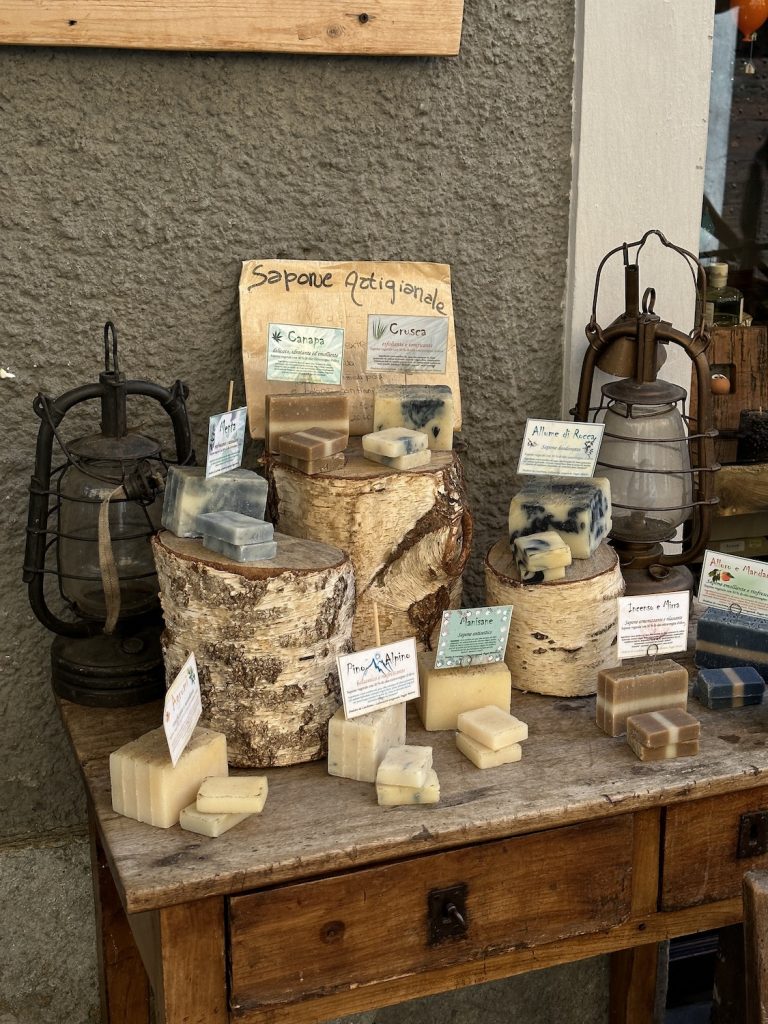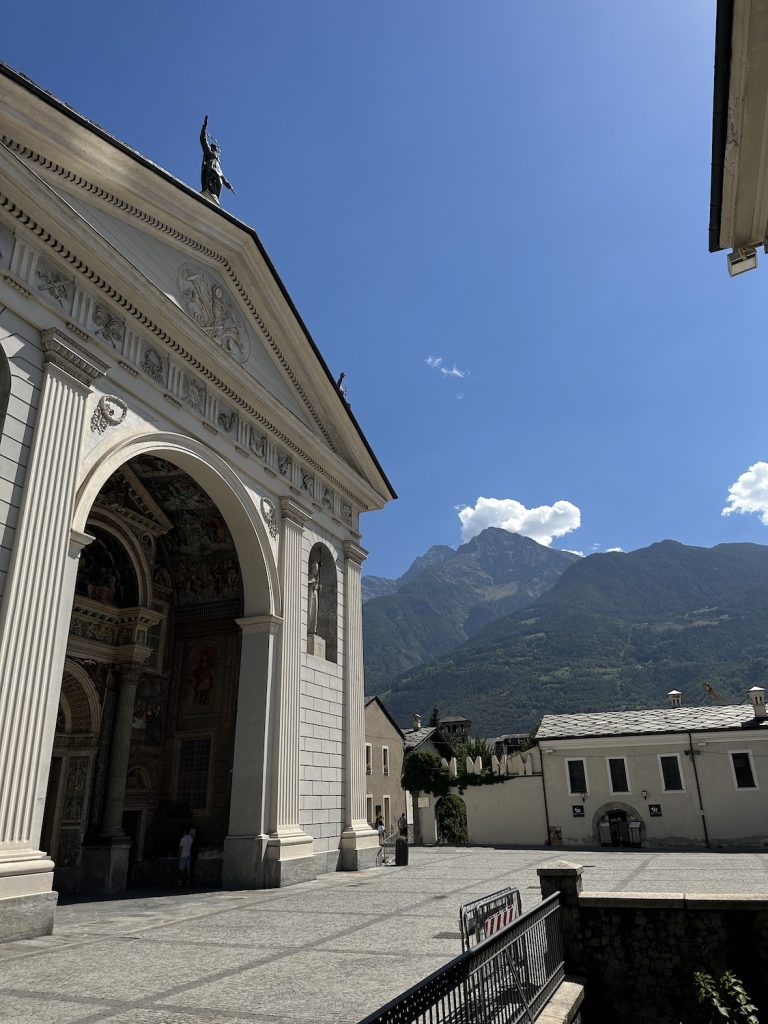Valle d’Aosta (Aosta Valley) deserves a prime spot on your Italy travel list. It’s a gem waiting to be discovered all year round. Being Italy’s smallest and least populated region, it’s often overlooked by tourists. But trust me, as a seasoned traveler and self-proclaimed Italian expert, I can assure you that it offers just as many attractions as the more famous areas of the country. Tucked amidst the breathtaking Alps, adorned with picturesque vineyards and majestic castles, Valle d’Aosta remains one of Italy’s best-kept secrets. With its fairytale-like towns, an exquisite mix of Italian, Swiss, and French cuisines, and truly exceptional hospitality, this tiny Italian gem should be calling your name. Let me share my insider tips for visiting Valle d’Aosta!

Valle d’Aosta by car
Traveling around Italy has not only been my long-term passion but also my side hustle as a travel creator in the past three years. Sounds dreamy, right? Yet, there’s a flip side. With extensive travel in one country, familiar patterns emerge, and that initial sense of novelty gradually fades. Just when I believed Italy held no more surprises for me, I found myself journeying through Valle d’Aosta by car. To say it was my best decision to stop there for longer would be an understatement. What I didn’t expect was that a trip to Italy’s smallest region would make me want to return again and again. There are many good reasons.
A little bit of history
The first thing that caught my eye in Valle d’Aosta was that the majority of road signs and street names were in both Italian and French. But was it surprising? Not at all! In fact, some Italian regions hold autonomous status, granting them unique legislative and administrative powers, including the recognition of multiple official languages. In the case of Valle d’Aosta, it’s French. It was adopted as the official language three years earlier than it happened in the Kingdom of France! So, while France was still widely using Latin for official documents, Valle d’Aosta embraced French as early as the mid-sixteenth century. To be even more precise, the exact language spoken in the region is Franco-Provençal and its various dialects. Italian became an official language only in 1861, after the unification of the country. Today, it is the most widely spoken language in Valle d’Aosta.
What to eat and drink
This international backdrop creates a distinctive fusion of cultures, all nestled within this seemingly diminutive region. The French and Swiss influence resonates strongly in local cuisine. It’s in the fonduta valdostana (a local take on the classic fondue) and Petite Arvine, a white wine made of the Petite Arvine grape. This variety is typical for Switzerland, but also commonly planted in Valle d’Aosta. And yet, the typical Italian polenta is a major staple on local tables, ensuring you remember you’re still in Italy!
Seupa à la vapelenentse
If you want to try something very local and specific to this region, I’d recommend Seupa à la vapelenentse, a typical soup made with white bread, butter, savoy cabbage broth, and Fontina cheese. Speaking of which, you absolutely shouldn’t miss this exceptional local cheese.
Carbonade
The carbonade is another classic that you’ll find across many restaurants in Valle d’Aosta. Imagine eating a tender beef stew cut into small pieces and cooked in red wine during cold winter days! As is often the case in mountainous regions, local cuisine might be rather heavy, but it makes for perfect comfort food.
Génépi
If you’re considering rounding off your lunch or dinner with an aperitif, don’t miss out on Génépi, a local herbal liquor. Though its taste tends to be more bitter compared to other digestifs, this traditional alpine beverage is a beloved choice throughout the region.
Now, if you’re looking for a perfect place to have your traditional lunch or dinner, I can absolutely recommend Osteria La Vache Folle. It’s located not far from Porta Pretoria. I loved the place for its rustic feel and amazing local food!
What to see in Valle d’Aosta


As I mentioned, despite its small size, Valle d’Aosta offers an abundance of attractions. My journey began with the exploration of Aosta, the region’s capital. Let me tell you, it’s unlike any other capital city! Aosta is a cozy and beautiful place, offering all the comforts of the typical alpine towns. Many of the local landmarks are conveniently clustered together in the city center, making it feasible to reach Aosta by train and explore further on foot.
However, I opted to travel by car, and I highly recommend this mode of exploration. It gives you the opportunity to venture beyond the city limits and discover the plethora of stunning castles scattered throughout the region. There’s a car park near the train station. However, I found parking directly on one of the streets to be just as convenient. The abundance of parking spaces is just one of the perks of this city not being well-known to tourists!
Wine degustation
No matter where you choose to begin, navigating around the city is a breeze — and I loved it a lot. We started our day in Via Aubert: a charming street lined with artisanal shops and small restaurants. It was a strategic move, of course, as we were looking forward to trying local wine in Decanter Aosta. It’s a modern enoteca with a rustic feeling, and it was absolutely perfect for a hot summer day, thanks to its outdoor sitting area.
The lovely staff told us a lot about the local wines and that was the precise reason I chose Decanter over some random wine bar: this place works with mostly small local producers. We learned a lot about local wines and had a chance to try the wine from a small winery located in the mountains and owned by the young brothers who are also first-generation winemakers. Oh, and the degustation is accompanied by local cheese, so it’s a perfect stop to start your exploration of the local culture!

Roman Heritage
As we turned around the corner, we literally bumped into the Roman Forum ruins: a splendid site, surrounded by the typically alpine houses and impressive mountains. It felt almost surreal to witness the timeless beauty of Ancient Roman architecture set against the Alpine landscape. But that’s what Aosta is like: a mix of cultures, views, and historical eras, all coexisting peacefully. Just steps away, we discovered Aosta’s cathedral, a magnificent 11th-century church. Its modern facade might be deceiving since it dates back to the 1800s.


As often happens, the church has seen many restorations and modifications, but you can still admire the original medieval constructions inside. Adjacent to the cathedral square lies the Roman Cryptoporticus, an underground gallery whose original purpose remains a mystery to this day. Some historians believe it served as a military gallery, while others think it might have functioned as a covered market. Regardless, this site stands as yet another testament to Aosta’s enduring history, spanning centuries, witnessing countless transformations, and remaining resolute amidst the passage of time.
The Roman Theatre and Porta Pretoria
My Roman-loving heart was not content yet, so we proceeded to another famous landmark of this small but mighty city – the Roman Theatre. Well, the remains of it, of course, but what a sight it is! Currently, the Theatre limits visitor access, but if you’re still interested in exploring, I recommend taking a small and narrow turn from Via Porta Praetoria (right after the Careri shop) that leads to the secret viewpoint.
Continuing our stroll up the street, we soon encountered Porta Praetoria itself —an ancient Roman gate, because, evidently, one can never have too many ancient landmarks in one place. Little did I realize then that just a few steps beyond the gate, we would stumble upon yet another hidden gem by sheer chance. I’m talking about the Early Christian church of San Lorenzo, of which the underground part dates back to the 5th century AD. The place was once located on the outskirts of the early medieval Aosta and acted as the funeral church.

Prehistoric sites
But Aosta offers even more than this mix of the Medieval and Roman landmarks. If your Roman Empire is a Prehistoric era (pun intended), Aosta has something for you, too! On the other side of the city, there is a huge archaeological site offering a glimpse into what life used to look like in the area way before the Romans came there — and it’s absolutely fascinating. The Area megalitica di Saint-Martin-de-Corléans museum showcases prehistoric tombs and other remnants, providing a fascinating glimpse into the area’s ancient past. What struck me most was the impeccable design of the site: the museum itself is a modern and spacious venue, boasting excellent lighting and well-thought-out itineraries, enhancing the overall experience.
And here we return to the point where I said your experience would be much richer with a car. While the majority of fascinating historical sites are conveniently located near the city center, several must-see attractions are situated a bit further afield. No visit to Valle d’Aosta would be complete without exploring its magnificent castles and fortresses. Indeed, you’ll encounter numerous castles simply by driving through the region—they’re practically impossible to miss! Some castles may lie in ruins, and others are situated on private property, yet many are open to visitors like you and me, offering a glimpse into the region’s storied past.
A treat for pop-culture enthusiasts

As a fan of the Marvel Cinematic Universe, I made a deliberate choice to visit a very specific castle (or rather, fortress) during my time in Valle d’Aosta. The Fort of Bard, situated approximately a 30-minute drive from Aosta, boasts a truly picturesque setting. Nestled amidst stunning mountains with a serene river flowing below, this majestic fortress looms over the town of Hône. Accessible via a funicular ride (which I highly recommend for some truly breathtaking views), a leisurely stroll around the medieval Borgo di Bard is a must before exploring the fortress itself. Hosting five permanent museums and various temporary collections, the fortress offers a rich cultural experience.
Now, why did I mention the Marvel Cinematic Universe? Well, as picturesque as it is, this fortress was chosen as the filming location for “Avengers: Age of Ultron” (2015), where it served as the base for the nefarious organization HYDRA in the fictional country of Sokovia.
And to wrap it up…


Valle d’Aosta is not something most people would think of when hearing the word “Italy”. But that’s exactly where this region’s strength lies! While it is not wildly popular, it enjoys relative freedom from crowds of tourists, offering peace and tranquility to nature lovers, history buffs, and just anybody who wants to explore lesser-known parts of Italy. You might not expect it, but chances are you will fall in love with Valle d’Aosta. It will make its way to your heart, making you want to come back for more. I fell for its charm right away – and I will forever be advocating Valle d’Aosta as the best alpine destination in Italy. It’s a place to discover, to try, to taste – and to fall in love, once and forever.
All images by Daria D.


